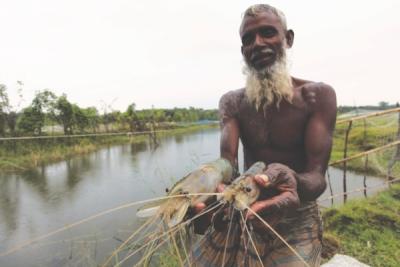Coastal Communities in Bangladesh 'Rising from Barren Lands'

Star Weekend
Special Feature
Volume 11 | Issue 41 | October 19, 2012
Coastal communities are hardest hit when natural disasters such as cyclones and floods visit Bangladesh's shores. An innovative pilot project is in its final six months of working to create alternative livelihoods for landless people and protecting the environment from future natural catastrophes. the Star's SORAYA AUER visited the initiative, which recently won an international award, in the coastal district of Barguna.
As an orange sun sets over the top of a mangrove forest, Hamida Begum, from Sonatala village, points to her stomach and says, “We do what we do because of this – hunger and poverty, understand? There was a time when we didn't know when our next meal would come but through this, we know we can eat and our other needs are guaranteed to be met.”
Hamida is referring to the ditch and dyke provided to her and her husband through the Community-based Adaptation to Climate Change through Coastal Afforestation project, an $8 million joint initiative by the Bangladesh government and United Nations Development Programme (UNDP). Since 2009, the pilot project has given almost 1,000 landless people in coastal districts access to otherwise unusable government lands to grow fruit, vegetables and fish. It has also attempted to reduce greenhouse gases and protect the land and people from further storms and erosion by planting new mangrove species along the coast.
Dr Paramesh Nandy, project manager of the initiative, explains, “There was nothing here before. Hundreds of hectares of land lying in between the mangrove forest and the embankment has been lying barren for years and years and is supposed to be encroached on in the future. Due to periodic inundation, it was not possible to grow anything here. To prevent people from encroaching on the forest for resources, we made this vertical use of the land, because horizontal was not possible.”
For the complete Star Weekend Special Feature, click here.
For more information on the CBACC-Coastal Afforestation project, read the full UNDP-ALM project profile here.